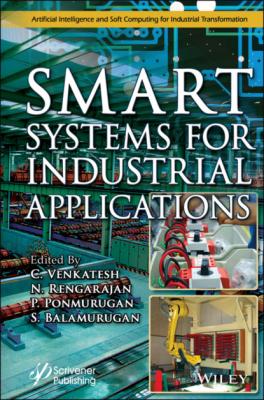Smart Systems for Industrial Applications. Группа авторов
Чтение книги онлайн.
Читать онлайн книгу Smart Systems for Industrial Applications - Группа авторов страница 18
 Kolker, E., Özdemir, V., Kolker, E., How Healthcare can refocus on its Super-Customers (Patients, n=1) and Customers (Doctors and Nurses) by Leveraging Lessons from Amazon, Uber, and Watson. OMICS, 20, 329–33, 2016.
Kolker, E., Özdemir, V., Kolker, E., How Healthcare can refocus on its Super-Customers (Patients, n=1) and Customers (Doctors and Nurses) by Leveraging Lessons from Amazon, Uber, and Watson. OMICS, 20, 329–33, 2016.
14. Dilsizian, S.E. and Siegel, E.L., Artificial intelligence in medicine and cardiac imaging: harnessing big data and advanced computing to provide personalized medical diagnosis and treatment. Curr. Cardiol. Rep., 16, 441, 2014.
15. Bhavnani, S.P., Narula, J., Sengupta, P.P., Mobile technology and the digitization of healthcare. Eur. Heart J., 37, 1428–1438, 2016, https://doi.org/10.1093/eurheartj/ehv770.
16. Tison, G.H., Sanchez, J.M., Ballinger, B., Singh, A., Olgin, J.E., Pletcher, M.J., Vittinghoff, E., Lee, E.S., Fan, S.M., Gladstone, R.A. et al., Passive detection of atrial fibrillation using a commercially available smartwatch. JAMA Cardiol., 3, 409–416, 2018, https://doi.org/10.1001/jamacardio.2018.0136.
17. Sengupta, P.P., Huang, Y.M., Bansal, M., Ashrafi, A., Fisher, M., Shameer, K., Gall, W., Dudley, J.T., Cognitive machine-learning algorithm for cardiac imaging: a pilot study for differentiating constrictive pericarditis from restrictive cardiomyopathy. Circ. Cardiovasc. Imaging, 9, e004330, 2016, https://doi.org/10.1161/CIRCIMAGING.115.004330.
18. Tsang, W., Salgo, I.S., Medvedofsky, D., Takeuchi, M., Prater, D., Weinert, L., Yamat, M., Mor-Avi, V., Patel, A.R., Lang, R.M., Transthoracic 3D echocardiographic left heart chamber quantification using an automated adaptive analytics algorithm. JACC: Cardiovasc. Imaging, 9, 769–782, 2016, https://doi.org/10.1016/j.jcmg.2015.12.020.
19. Lancaster, M.C., Salem Omar, A.M., Narula, S., Kulkarni, H., Narula, J., Sengupta, P.P., Phenotypic clustering of left ventricular diastolic function parameters: patterns and prognostic relevance. JACC: Cardiovasc. Imaging, 12, 7, 1149–1161, 2018, https://doi.org/10.1016/j.jcmg.2018.02.005. [epub].
20. Zhang, J., Gajjala, S., Agrawal, P., Tison, G.H., Hallock, L.A., Beussink-Nelson, L., Lassen, M.H., Fan, E., Aras, M.A., Jordan, C. et al., Fully automated echo-cardiogram interpretation in clinical practice. Circulation, 138, 1623–1635, 2018, (https://doi.org/10.1161/CIRCULATIONAHA.118.034338).
21. Movassaghi, S., Abolhasan, M., Lipman, J., Smith, D., Jamalipour, A., Wireless Body Area Networks: A Survey. IEEE Commun. Surv. Tutor., 16, 3, 1658–1686, 2014.
22. Rodrigues, J.J.P.C. et al., Enabling Technologies for the Internet of Health Things. IEEE Access, 6, 13129–13141, 2018.
23. Ooi, P., Culjak, G., Lawrence, E., Wireless and wearable overview: stages of growth theory in medical technology applications. International Conference on Mobile Business (ICMB’05), IEEE, 2005.
24. Khalid, H. et al., A comprehensive review of wireless body area network. J. Netw. Comput. Appl., 143, 178–198, 2019.
25. Al-Janabi, S. et al., Survey of main challenges (security and privacy) in wireless body area networks for healthcare applications. Egypt. Inform. J., 18, 2, 113–122, July 2017.
26. Sangita Singh, S., Artificial Intelligence and the Internet of Things in Healthcare, Healthcare and Life Sciences, 2018, accessed 6 April 2018, https://thejournalofmhealth.com/artificial-intelligence-and-the-internet-of-thingsin-healthcare.
27. Azimi, I. et al., HiCH: Hierarchical Fog-Assisted Computing Architecture for Healthcare IoT. ACM Trans. Embed. Comput. Syst., 16, 5s, 1–20, Sept. 2017.
28. Baskar, S., A dynamic and interoperable communication framework for controlling the operations of wearable sensors in smart healthcare applications. Comput. Commun., 149, 17–26, Jan. 2020.
29. Deepak, B.D., Al-Turjman, F., Aloqaily, M., Alfandi, O., An Authentic-Based Privacy Preservation Protocol for Smart e-Healthcare Systems in IoT. IEEE Access, 7, 135632–135649, 2019.
30. Bejnordi, B.E., Veta, M., van Diest, P.J. et al., Diagnostic Assessment of deep learning algorithms for detection of lymph node metas-tases in women with breast cancer. JAMA, 318, 2199–2210, 2017.
31. Saba, L., Biswas, M., Kuppili, V. et al., The present and future of deep learning in radiology. Eur. J. Radiol., 114, 14–24, 2019.
32. Francis, N.K., Luther, A., Salib, E. et al., The use of artificial neural networks to predict delayed discharge and readmission in enhanced recovery following laparoscopic colorectal cancer surgery. Tech. Coloproctol., 19, 419–428, 2015.
33. Rabbani, M., Kanevsky, J., Kafi, K. et al., Role of artificial intelligence in the care of patients with non small cell lung cancer. Eur. J. Clin. Invest., 48, 1–7, 2018.
34. Obrzut, B., Kusy, M., Semczuk, A. et al., Prediction of 5-year overall survival in cervical cancer patients treated with radical hysterectomy using computational intelligence methods. BMC Cancer, 17, 840, 2017.
35. Murugesan, Y.P., Alsadoon, A., Manoranjan, P., Prasad, P.W.C., A novel rotational matrix and translation vector algorithm: geometric accuracy for augmented reality in oral and maxillofacial surgeries. Int. J. Med. Robot., 14, e1889, 2018.
36. Bourdel, N., Collins, T., Pizarro, D. et al., Augmented reality in gynecologic surgery: evaluation of potential benefits for myomectomy in an experimental uterine model. Surg. Endosc., 31, 456–461, 2017.
37. Mendivil, A.A., Abaid, L.N., Brown, J.V. et al., The safety and feasibility of minimally invasive sentinel lymph node staging using indocyanine green in the manage-ment of endometrial cancer. Eur. J. Obstet. Gynecol. Reprod. Biol., 224, 29–32, 2018.
38. Waran, V., Narayanan, V., Karuppiah, R. et al., Utility of multi material 3D printers in creating models with pathological entities to enhance the training experience of neurosurgeons. J. Neurosurg., 120, 489–492, 2014.
1 *Corresponding author: [email protected]
2
Pneumatic Position Servo System Using Multi-Variable Multi-Objective Genetic Algorithm–Based Fractional-Order PID Controller
D.Magdalin Mary1*, V.Vanitha2 and G.Sophia Jasmine1
1 Department of Electrical and Electronics Engineering Sri Krishna College of Technology, Coimbatore, Tamilnadu, India 2 Department of Electrical and Electronics Engineering, VSB College of Engineering Technical Campus, Coimbatore, Tamilnadu, India